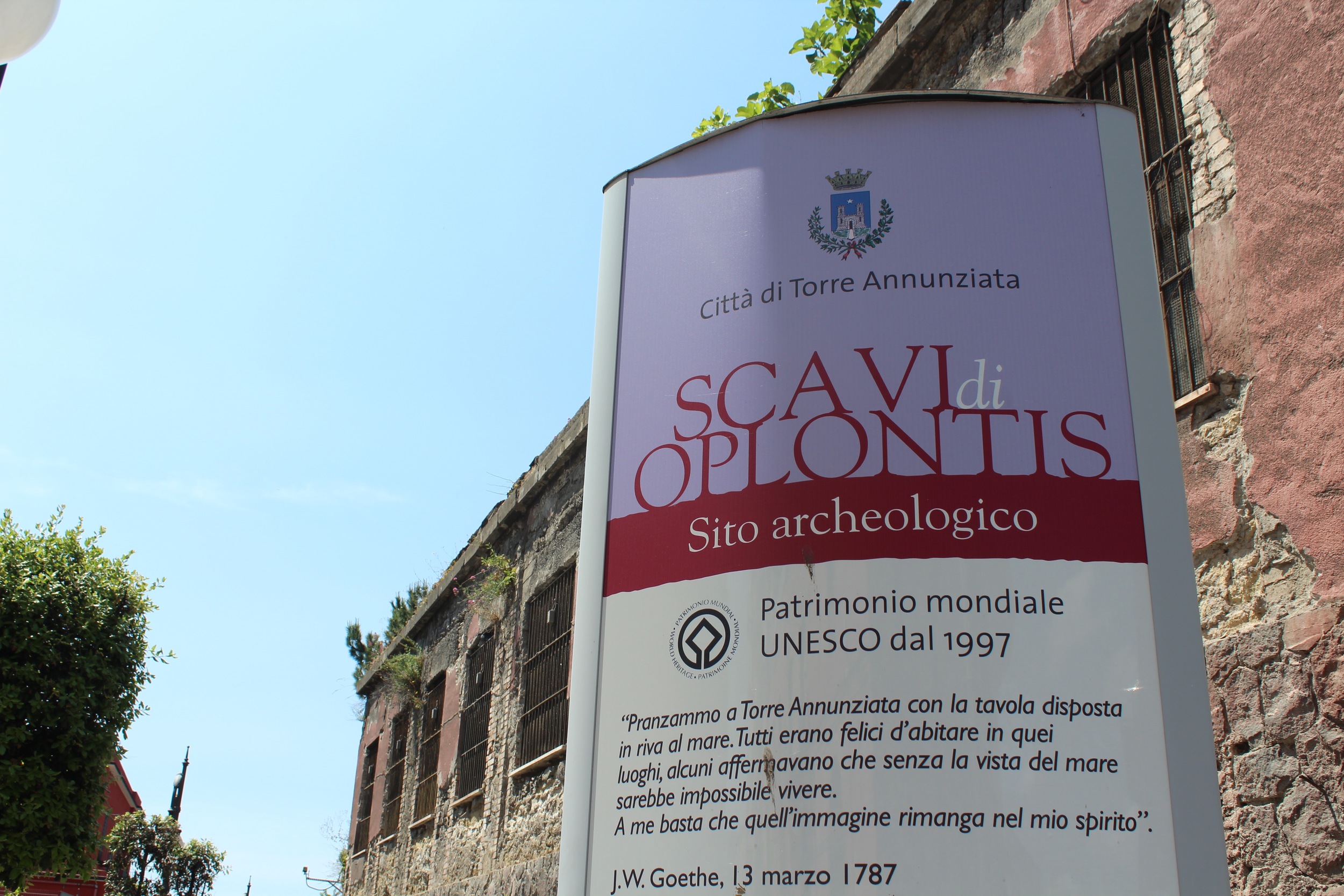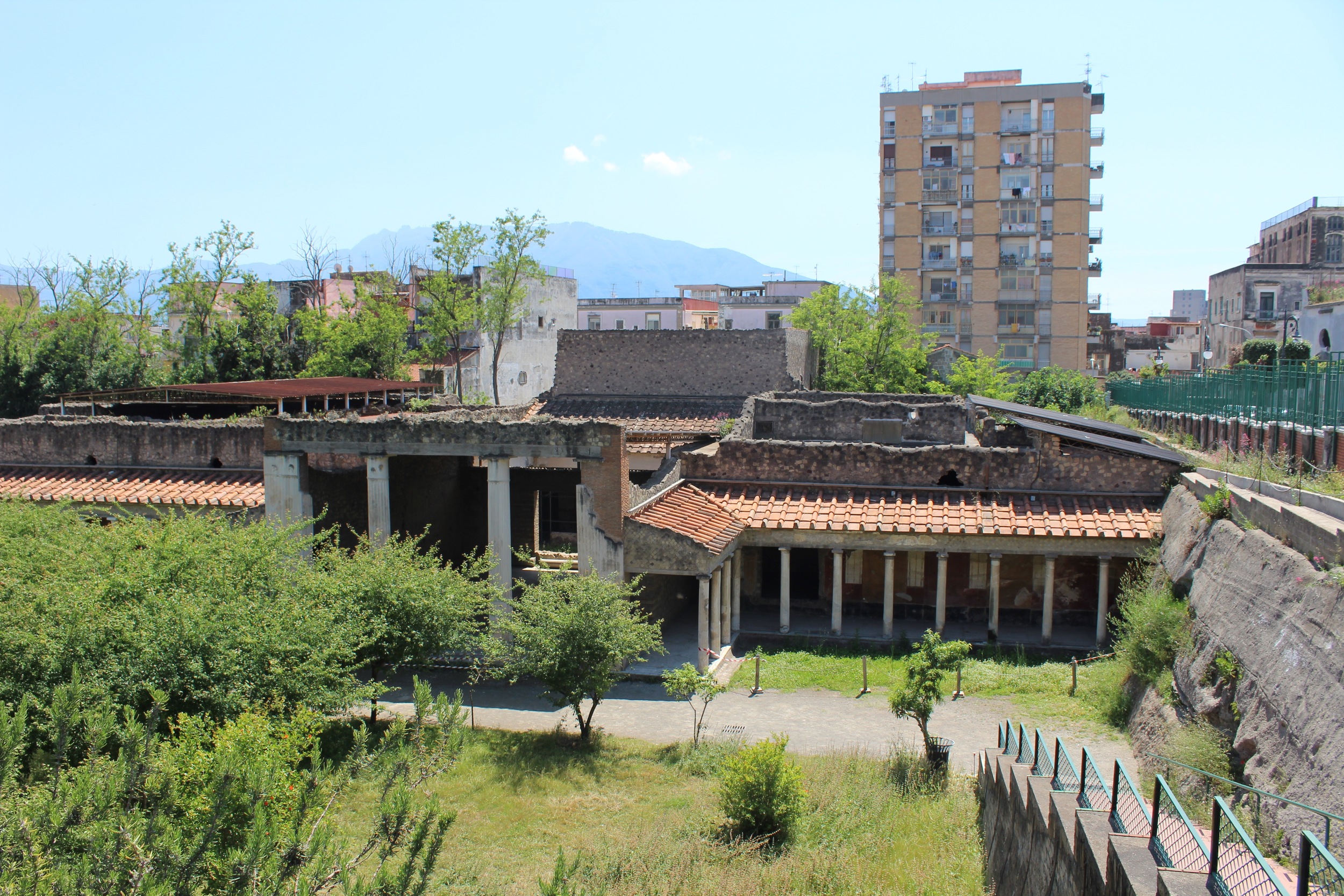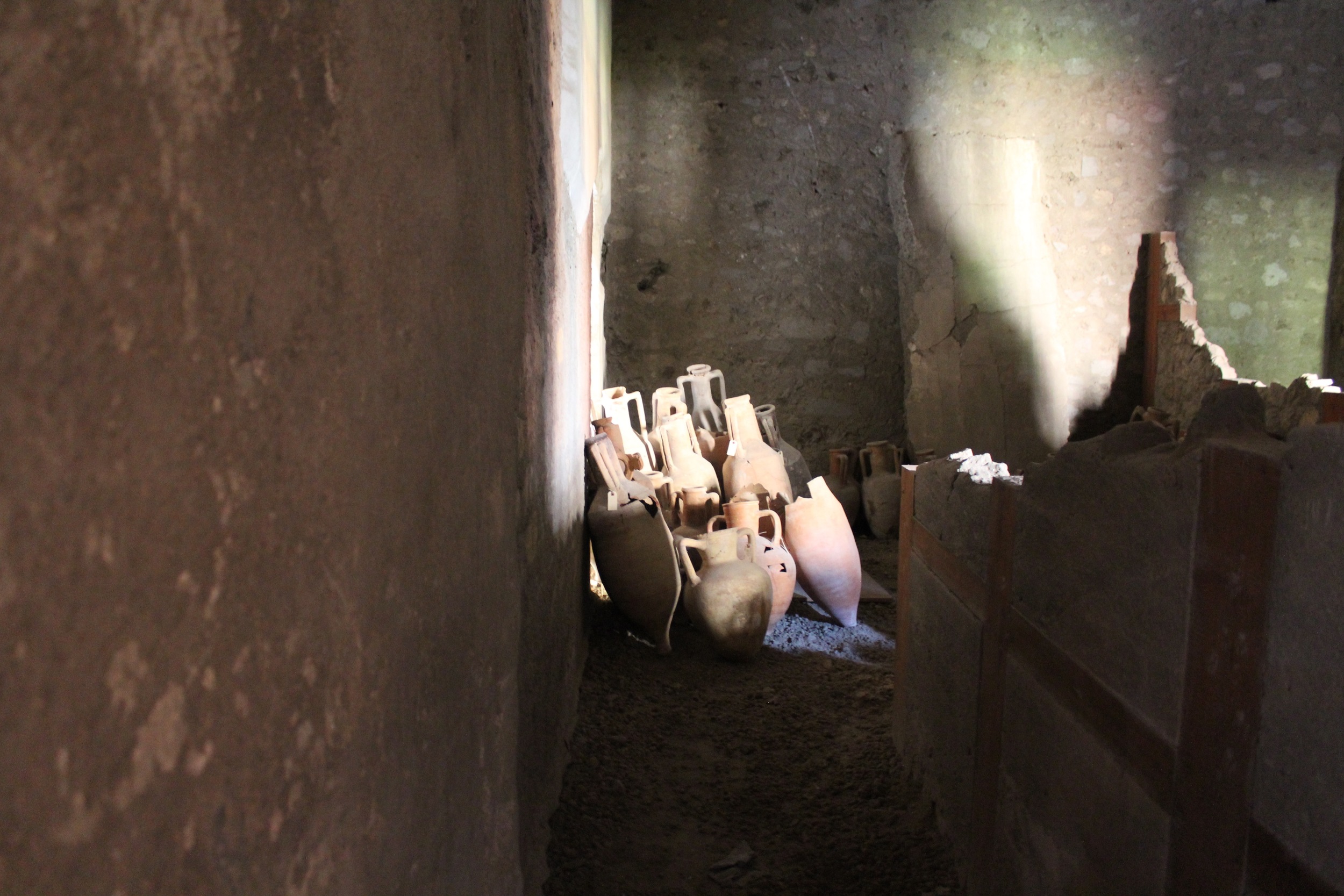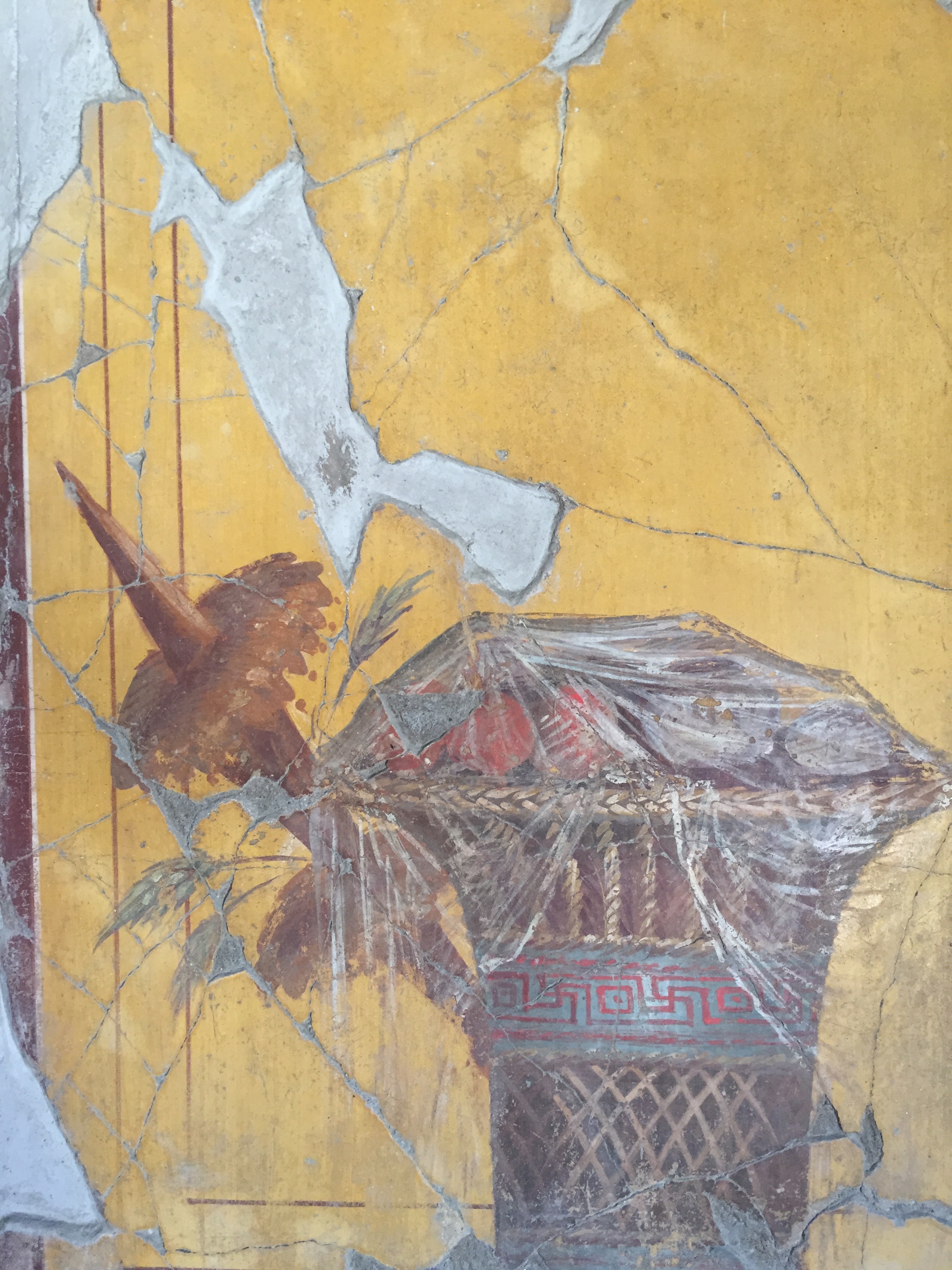What's inside the Villa Oplonti
During a cooking class on our May food and wine tour, Baronessa Cecilia Baratta Bellelli told me how Italians were outraged that treasures recently excavated at a site called Villa Oplonti could be seen be seen in Montana when locals had not even had the opportunity to view them.
"But perhaps the exhibition will help to bring more tourists," she surmised. "It really is fabulous."
Since I always take the Baronessa's advice, I went to Torre Annunziata, a suburb of Naples to see the Villa which was once in a suburb of Pompeii. The apartment buildings just outside the Circumvesuviana train station looked tattered though there was plenty of signage pointing visitors toward the "scavi di Oplontis." Groups of local teenagers were hanging around the snack stand while African men hauled enormous sacks of fake handbags to sell to tourists in Naples or Sorrento. An image of "La Madonna della Neve", the patroness of the city looked down from just above the turnstiles.
Antonio and Giovanna at the DocSicili-Oplontis sandwich shop are the unofficial welcoming committee for hungry tourists. Their shop at 26 Via Sepolcri is filled with the pride of the city; a shelf stocked with bags of Pasta Setaro and framed newspaper clippings about the ruins. Once an opulent Roman seaside retreat, Villa Oplonti was buried during the same eruption of Mount Vesuvius that immolated and immortalized Pompeii.
We chatted as they settled me down with a salame sandwich and when I shared that I worked at a museum, Antonio asked if I knew of their good friends, the professors and archaeologists from the University of Texas, Austin.
"Vieni," he said, waving me toward a door that led to a small dining room with picnic style tables. The walls were covered from floor to ceiling with more framed photos, these showing smiling groups of American students feasting at these same tables.
"We prepare many beautiful meals for our American friends here. Soon they will arrive to start a new season of work," Antonio explained.
The modern day city of Torre Annunziata is built over the Roman city of Oplontis, a quiet, seaside town outside of more bustling Pompeii. "Villa A" is how scholars refer to Villa Oplontis. Locals however call it Villa Poppea, named for the Emperor Nero's wife for whom the Villa may have been built. Just next door is "Villa B" or Villa Lucius Crassius Tertius, which seems to have been a distribution center for wine and garum. (It is not open to public visitors.) The modern city rises all around the two ancient sites.
Enter the VIlla Oplontis from Via Sepolcri. Buy a ticket at the small office and enter via a staircase which descends into the ruins.
When Mount Vesuvius erupted on August 24, 79 C.E., Villa Oplonti was undergoing a renovation and had no occupants. 54 skeletons of both nobles and slaves have been found next door at Villa B, crowded near a doorway, likely waiting to be rescued by boat.
It was an especially opulent villa that more austere Roman elites in the capital who would have frowned upon. Displays of excess could be hidden in the lush territory south of Rome called Campania. Though scholars just aren't sure that Poppea Sabina, second wife of Nero lived here (she who remains infamous for her bisexual romps and milk baths), the Villa was certainly a place that belonged to someone from the Roman senatorial class and designed for the purposes of relaxation and pleasure.
The site was first discovered in the 16th century, but not excavated until the 18th century when it fell under the auspices of the Bourbon Kings of Naples who oversaw the re-discovery of the site at Pompeii. Work resumed between the 1960s and 80s but was abandoned once again. In 2005, work was reignited with The Oplontis Project led by John R. Clarke and Michael L. Thomas of the University of Texas at Austin and in collaboration with the Soprintendenza Speciale per i Beni Archeologici di Napoli e Pompei.
The modern city of Torre Annunziata surrounds the ruins of Villa Oplontis.
In early May 2016, I was one of only a handful of visitors at the Villa Oplonti, a blissful respite from the crowded streets of Naples. I spent almost three hours wandering through the spaces where the ongoing work of scholars is easily apparent. Many spaces are roped off to store artifacts and archaeology tools.
Amphorae were used to store and transport wine and garum, a fermented fish sauce that was an extremely popular condiment in the Roman empire.
The Villa's lavishness is best demonstrated by an enormous swimming pool, once surrounded by meadows, trees and flowers. Golden statues would have lined the pools edge. Historians speculate that it was actually an infinity pool where water dropped off a 40 foot cliff.
Remains of the enormous swimming pool at Villa Oplontis. The stairs descending into the pool are visible in the left-hand corner.
Throughout the home are stunning zebra pattern walls which scholars believe were utilitarian markers for the Villa's slaves. To work at such an opulent villa meant that the staff would have had to move through the spaces in choreographed patterns like the staff today at a fine dining restaurant or super yacht.
The Villa Oplonti undoubtedly hosted tremendous feasts where nobles and politicians would have flexed their rank and made deals. The Satyricon is a point of reference for decadent Roman feasts where upon entering would be offered candied door mice from large glass jars. While dinner party guests lounged on beds in the triclinium, eating with their hands, servants would have been busy offering them serving trays laden with food and wine. Seafood would be at the ready in large tanks along the waters edge.
In one of several sitting rooms is a fresco of a delicate cake displayed on an ornate serving dish. This may be a culinary ancestor of "cassata siciliana", a cake wrapped in a thin layer of marzipan. It could also be a tart made of dried fruits, walnuts, ricotta cheese and honey. Whole pieces of fruit decorate the glazed surface.
Another possibility is that this could be the rosis patina or rose pie described in the famous cookbook of lavish Roman dishes, De re coquinaria ("On the Subject of Cooking") by Caelius Apicius. Red rose petals would would be cooked down in in broth, then pulverized with calves brains, mixed with beaten eggs, raisin wine, pepper and oil. The mixture was then poured into a round mold and cooked in a bain maris or a hot bath used for delicate custards or gelatins.
Roman cake that would have been served to nobles and elites during elaborate banquets.
Another richly decorated vase holds fruit covered by a silk veil so thin it looks like plastic wrap. In another fresco, a glass bowl above an illusionistic doorway holds plums and pomegranates. The painter of this room seems to be showing off his mastery of depicting transparent surfaces.
I strongly recommend a visit to the the Villa Oplonti as a day trip from Naples or Sorrento. While the ruins at Pompeii and Herculaneum area a must-see, they can also be overwhelming. This intimate, focused view of one dwelling allows for a transportive, almost dream-like experience of Roman Italy.
In reaction to the exhibitions in America that the Baronessa mentioned, an exhibition of 72 objects excavated at both Villas A & B was organized inside Torre Annunziata at Palazzo Criscuolo (Corso Vittorio Emanuele III, 251, 80058)
"Oplontis: The Charm and Beauty" is open daily from 9.30 – 13.30 and 15.30 – 19.30, and admission is only 3,00€
In the United States, the treasures of both Villas A & B can be seen in the traveling exhibition "Leisure and Luxury in the Age of Nero: The Villas of Oplontis near Pompeii."
The next tour stops are Museum of the Rockies at the Montana State University, Bozeman from June 17-December 31, 2016 and the Smith College Museum of Art in Northampton, Massachusetts from February 3-August 13, 2017.
Here's how to visit the Villa Oplonti
Via Sepolcri, 80058 Torre Annunziata NA, Italy +39 081 8575347
Take the Circumvesuviana from Napoli Centrale to Torre Annunziata
October 1st - October 31st daily 08.30 - 19.30 (last entry 18.00). November 1st - March 31st daily 08.30 - 17.00 (last entry 15.30).
1 Day/3 Sites: Adults €5,50, Reduced €2,75 (Boscoreale, Oplontis, Stabia); 3 Days/5 Sites: Adults €20,00, Reduced €10,00 (Boscoreale, Herculaneum, Oplontis, Pompeii, Stabia)
Click here to read more about the American tour of treasures from Villa Oplonti.


















